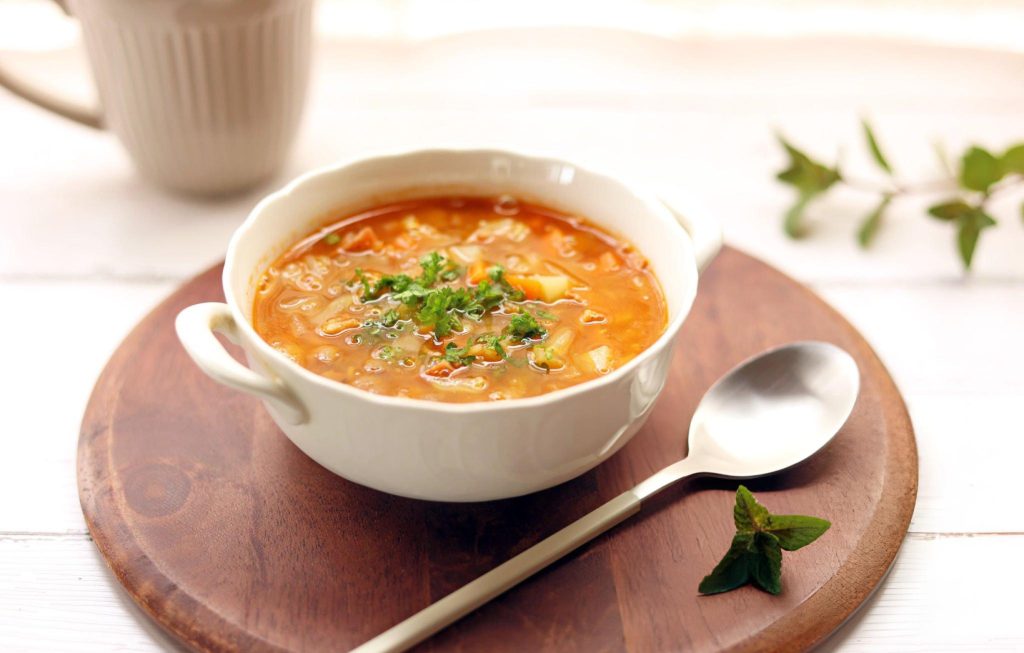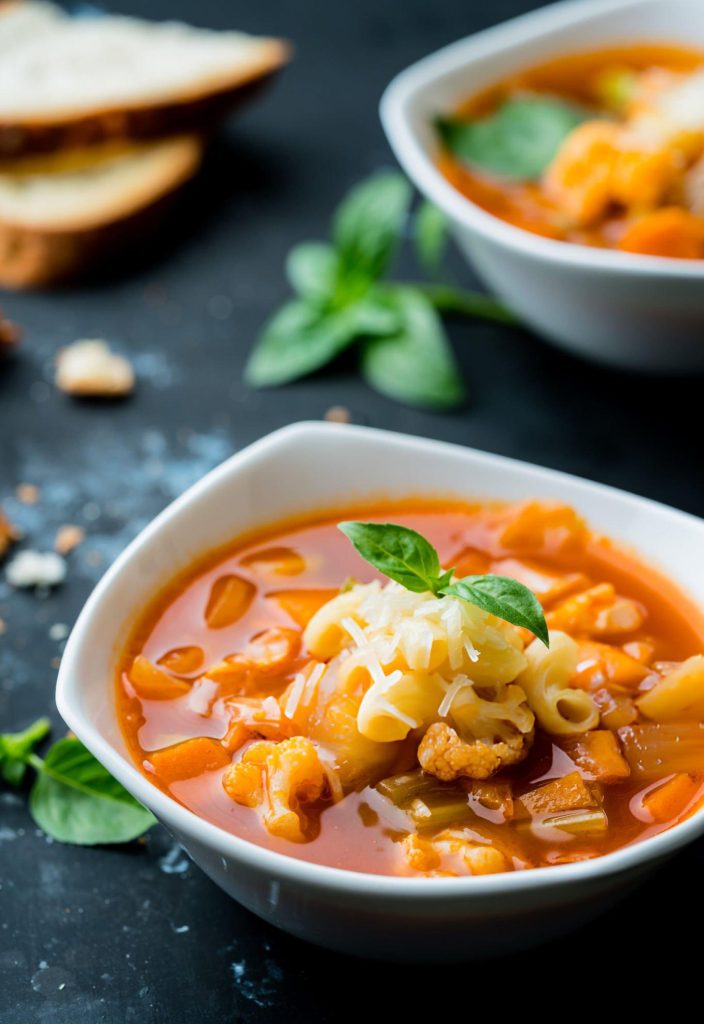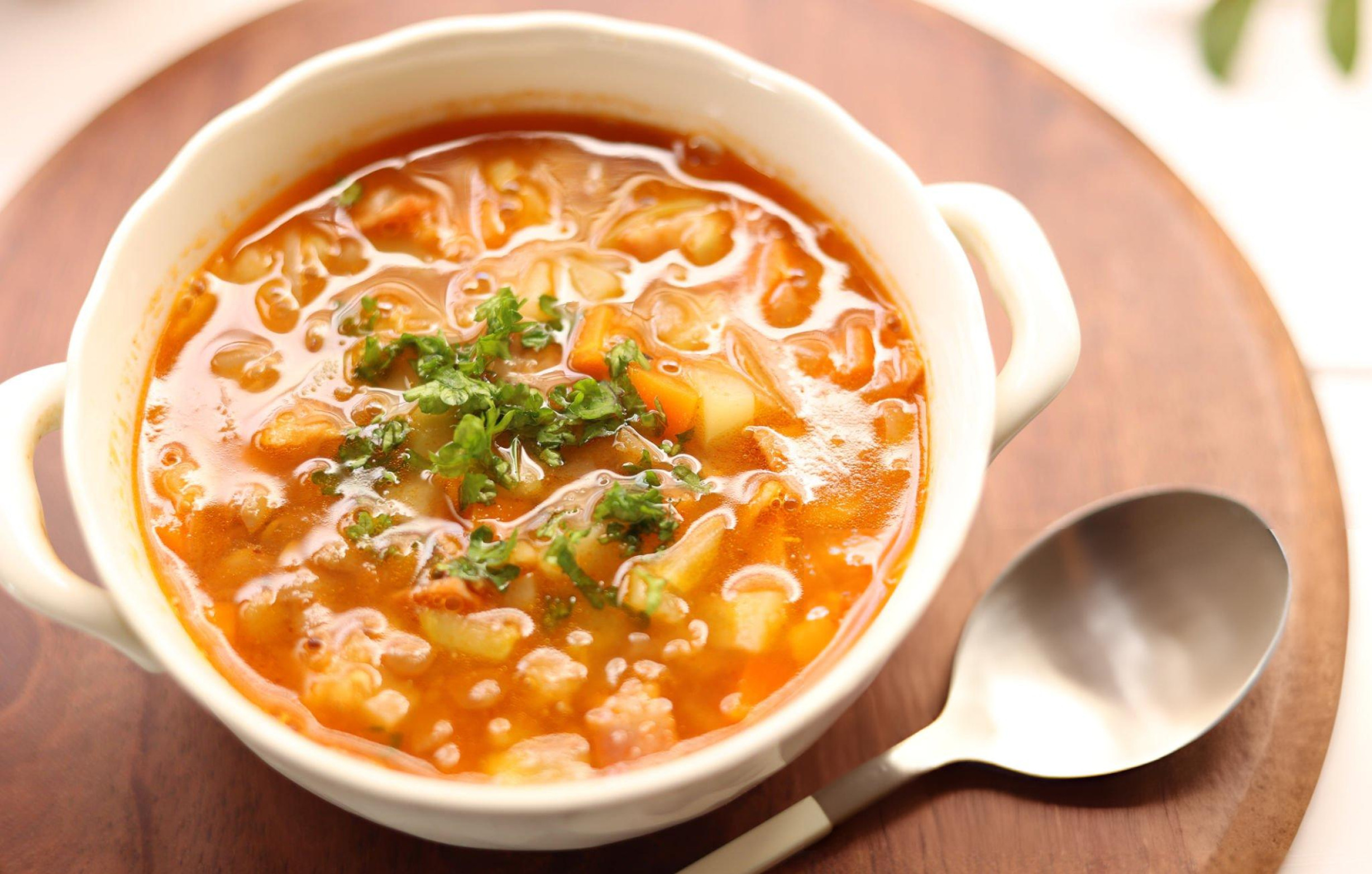Minestrone Soup Recipe
Minestrone soup is a classic Italian dish that embodies the heartiness of a home-cooked meal while offering the versatility to suit any season. This vibrant soup is packed with fresh vegetables, beans, and pasta, simmered in a rich broth that brings warmth and comfort to every bowl. Whether you’re looking to create a wholesome dinner for the family or a meal prep option that lasts through the week, this Minestrone soup recipe is your go-to for a nutritious and satisfying dish.

Ingredients Overview
A well-prepared Minestrone soup starts with a medley of vegetables and a few essential pantry staples. The base of the soup is a flavorful vegetable broth, which forms the canvas upon which layers of taste and texture are built. White beans or kidney beans add a creamy richness, while diced tomatoes infuse the broth with a touch of acidity and sweetness. Small pasta shapes like elbows or orecchiette provide a tender bite, perfectly complementing the chopped carrots, green beans, celery, and onions that bring an earthy depth to the soup. Aromatics such as garlic, bay leaves, oregano, and thyme further elevate the flavor, while a garnish of fresh parsley and red pepper flakes offers a burst of freshness and subtle heat.
While these ingredients are traditional, the beauty of Minestrone lies in its adaptability. You can easily substitute the beans with other varieties like cannellini or chickpeas, and swap out the pasta for gluten-free options or even whole grains like quinoa. The herbs and spices can also be adjusted to suit your palate, allowing you to create a soup that is uniquely yours.
Step-by-Step Instructions
To achieve the perfect Minestrone, start by preparing your vegetables. Dicing the onion, chopping the carrots, and slicing the celery into uniform pieces ensures even cooking, allowing each vegetable to release its natural sweetness. When sautéing these vegetables, it’s important to cook them slowly over medium heat. This gentle cooking method allows the flavors to develop and meld together, creating a strong foundation for the soup.
Once the vegetables have softened, it’s time to build the soup’s body. Adding grated garlic and stirring it until fragrant infuses the soup with a robust aroma, while the addition of diced tomatoes, beans, green beans, and broth introduces layers of flavor and texture. Simmering the soup covered for 20 minutes allows the ingredients to blend harmoniously, resulting in a rich and cohesive broth.
The final step is to cook the pasta. Stirring it into the soup and allowing it to cook uncovered ensures that the pasta absorbs the broth’s flavors while maintaining its al dente texture. The key here is to taste as you go, adjusting the seasoning with salt and pepper to suit your preference. Serving the soup with a sprinkle of fresh parsley, a pinch of red pepper flakes, and a dash of grated Parmesan cheese adds the finishing touches that transform this humble dish into a gourmet experience.
Recipe Tips & Frequently Asked Questions
- Achieving the Perfect Consistency: The consistency of your Minestrone can vary from brothy to stew-like. If you prefer a thicker soup, reduce the broth slightly or add a spoonful of tomato paste for extra body. For a lighter version, increase the broth and enjoy a more soupy texture.
- Preventing Overcooked Vegetables and Pasta: To avoid mushy vegetables and pasta, make sure to cook them just until tender. Adding the pasta towards the end of the cooking process ensures it retains its bite without becoming overly soft.
- Enhancing the Flavor: Seasoning is key to a flavorful Minestrone. Adjust the salt and pepper after simmering, and consider adding a splash of balsamic vinegar or lemon juice for a bright finish.
- Make-Ahead and Storage Tips: Minestrone is an excellent make-ahead dish. Allow the soup to cool completely before storing it in an airtight container in the refrigerator for up to five days. It also freezes well—just be sure to leave out the pasta and add it fresh when reheating.
- Bean and Pasta Substitutions: Feel free to experiment with different beans and pasta shapes. Cannellini beans offer a creamier texture, while chickpeas add a nutty flavor. Whole grain or gluten-free pasta works just as well as traditional options.
- Making it Gluten-Free or Vegan: To make this recipe gluten-free, simply use gluten-free pasta. For a vegan version, omit the Parmesan cheese or substitute it with a vegan cheese alternative.
- Storing Leftovers: Leftover Minestrone should be cooled and stored in the refrigerator for up to five days. Reheat gently on the stove to preserve the texture of the vegetables and pasta.
- Adding Meat: If you’d like to add protein, cooked Italian sausage, ground beef, or shredded chicken are all great options. Add the meat towards the end of the cooking process to avoid overcooking.

What to Serve With This Recipe
Minestrone soup pairs beautifully with a variety of sides and beverages. Crusty bread, whether a rustic sourdough or a soft dinner roll, is perfect for soaking up the flavorful broth. A simple green salad with a tangy vinaigrette provides a refreshing contrast, while roasted vegetables add another layer of warmth and heartiness to the meal. For drinks, consider serving the soup with a light white wine, such as Pinot Grigio, or a herbal tea like chamomile to complement the earthy flavors of the soup. Garnishing the soup with fresh parsley, red pepper flakes, and a sprinkle of Parmesan cheese not only enhances the taste but also elevates the presentation, making the meal feel special.
Customizing Your Vegetable Soup
Minestrone is a soup that lends itself to customization, making it ideal for any time of year. In the summer, you can incorporate fresh zucchini, corn, or tomatoes, while root vegetables like potatoes, parsnips, and turnips are perfect for a hearty winter version. Adding extra vegetables is easy—simply chop them to a similar size as the other ingredients and adjust the simmering time accordingly. If you enjoy a bit of spice, increase the amount of red pepper flakes or add a dash of hot sauce to give the soup a kick. The versatility of Minestrone means that you can adapt the recipe to your taste preferences and dietary needs, creating a dish that feels both comforting and personalized.
Serving and Presentation Suggestions
The way you serve and present Minestrone can transform it from a simple meal to a dining experience. Choose bowls that are deep enough to hold plenty of broth, yet wide enough to showcase the colorful medley of vegetables and pasta. For a rustic touch, serve the soup with a side of freshly baked bread on a wooden board, accompanied by a small dish of olive oil for dipping. Garnishing the soup with freshly chopped parsley, a sprinkle of Parmesan cheese, and a few flakes of red pepper adds visual appeal and a burst of flavor with each bite. For an extra touch of elegance, drizzle a bit of high-quality extra-virgin olive oil over the top just before serving.
Minestrone soup is more than just a meal—it’s an opportunity to experiment with flavors, textures, and ingredients. Whether you’re following the recipe to the letter or making adjustments to suit what’s in your pantry, this soup is sure to satisfy. Don’t be afraid to make it your own by adding your favorite vegetables, switching up the pasta, or experimenting with herbs and spices. And remember, the best recipes are the ones that evolve over time, so take joy in the process of creating a dish that’s uniquely yours. We invite you to share your own customizations and serving ideas, and most importantly, enjoy every spoonful of this classic Italian favorite.

Ingredients
- 4 cups vegetable broth
- 1½ cups cooked white beans or kidney beans, drained and rinsed
- 1 (28-ounce) can diced tomatoes
- ¾ cup small pasta, elbows, shells, orecchiette
- 2 medium carrots, chopped
- 1 cup chopped green beans
- 2 tablespoons extra-virgin olive oil
- 1 medium yellow onion, diced
- 2 celery ribs, thinly sliced
- 1 teaspoon sea salt, plus more to taste
- Freshly ground black pepper
- 3 garlic cloves, grated
- 2 bay leaves
- 1 teaspoon dried oregano
- 1 teaspoon dried thyme
- ½ cup chopped fresh parsley
- Red pepper flakes
- Grated Parmesan cheese, optional, for serving
Instructions
Warm the olive oil in a large pot over medium heat. Add the diced onion, chopped carrots, sliced celery, and a pinch of sea salt, along with several twists of freshly ground black pepper. Stirring occasionally, sauté the vegetables for around 8 minutes, or until they begin to soften and become fragrant.
Incorporate the grated garlic, diced tomatoes with their juices, rinsed beans, chopped green beans, vegetable broth, bay leaves, dried oregano, and thyme. Bring the mixture to a simmer, cover the pot, and let it cook gently for 20 minutes, allowing the flavors to meld together.
Next, add the small pasta to the pot, stirring well to combine. Cook the soup uncovered for an additional 10 minutes, or until the pasta reaches al dente perfection.
Taste and adjust the seasoning, adding more salt or pepper if needed. Serve the soup hot, garnished with fresh parsley, a pinch of red pepper flakes, and a sprinkle of grated Parmesan cheese, if desired.

Minestrone Soup Recipe
Ingredients
- 4 cups vegetable broth
- 1½ cups cooked white beans or kidney beans drained and rinsed
- 1 28-ounce can diced tomatoes
- ¾ cup small pasta elbows, shells, orecchiette
- 2 medium carrots chopped
- 1 cup chopped green beans
- 2 tablespoons extra-virgin olive oil
- 1 medium yellow onion diced
- 2 celery ribs thinly sliced
- 1 teaspoon sea salt plus more to taste
- Freshly ground black pepper
- 3 garlic cloves grated
- 2 bay leaves
- 1 teaspoon dried oregano
- 1 teaspoon dried thyme
- ½ cup chopped fresh parsley
- Red pepper flakes
- Grated Parmesan cheese optional, for serving
Instructions
- Warm the olive oil in a large pot over medium heat. Add the diced onion, chopped carrots, sliced celery, and a pinch of sea salt, along with several twists of freshly ground black pepper. Stirring occasionally, sauté the vegetables for around 8 minutes, or until they begin to soften and become fragrant.
- Incorporate the grated garlic, diced tomatoes with their juices, rinsed beans, chopped green beans, vegetable broth, bay leaves, dried oregano, and thyme. Bring the mixture to a simmer, cover the pot, and let it cook gently for 20 minutes, allowing the flavors to meld together.
- Next, add the small pasta to the pot, stirring well to combine. Cook the soup uncovered for an additional 10 minutes, or until the pasta reaches al dente perfection.
- Taste and adjust the seasoning, adding more salt or pepper if needed. Serve the soup hot, garnished with fresh parsley, a pinch of red pepper flakes, and a sprinkle of grated Parmesan cheese, if desired.

